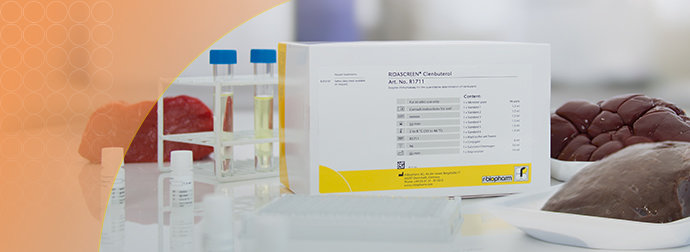
Recent news in Food & Feed Analysis
- Home
- /
- Clenbuterol in food: a...
Clenbuterol in food: a risk to the consumer?

Doping was again a big topic during the Olympic Games. One of the prohibited substances is Clenbuterol – a drug also used for fattening livestock due to its anabolic effect. Drug residues remain in meat and milk from treated animals and may pose a health risk to the consumer. A new ELISA test enhances the detection of anabolic residues in food.
Clenbuterol, a beta-agonist, is actually a drug used for the treatment of asthma. At high dosage, it boosts metabolism, stimulates the fat burning process and promotes muscle building, which is why it has been misused as a doping substance. In addition, it can be used in livestock in order to promote growth and improve the meat-fat-ratio. Yet, the use of Clenbuterol has consequences: drug residues remain in meat and milk from treated animals.
These residues are a problem especially for athletes: after eating contaminated meat, they might be tested positive in doping control. This is why athletes have been repeatedly warned not to eat meat (particularly from Chinese or Mexican sources). However, anabolic residues can also bear health risks for consumers. Clenbuterol can increase the heart rate and cause muscle tremors. Further possible side effects are fever, headache, dizziness, nervousness and nausea.
Analysis of anabolic residues
In terms of consumer protection, the EU has banned the use of hormones and anabolic steroids as growth promoter in livestock farming. There are strict maximum residue levels (MRL) for Clenbutrol:
- 0.1 μg/kg in beef
- 0.5 μg/kg in bovine liver
- 0.5 μg/kg in bovine kidney
- 0.05 μg/kg in cow’s milk
However, the use of Clenbuterol as growth promoter is legal in some other countries. Testing food for possible residues is therefore important to avoid sanctions.
In order to simplify the analytical process for the detection of anabolic agents, we have developed the new ELISA test RIDASCREEN® Clenbuterol (R1711). This test will enable a quantitative screening of food and feed as well as of urine, plasma/serum, hair and eyeballs. The kit will replace the former tests RIDASCREEN® Clenbuterol Fast (R1701) and RIDASCREEN® Clenbuterol (R1705) and offers several advantages, including improvements in sensitivity and recovery.
RIDASCREEN® Clenbuterol (R1711)
- Test format: ELISA
- Matrices: Meat, milk, liver, kidney, urine, plasma/serum, hair, eyeballs, feed
- Sample preparation: Simplified sample preparation without use of IAC or SPE columns. Direct use of milk, urine and plasma/serum samples without sample preparation.
- Test implementation: Less pipetting through functionalized microtiter plate. All reagents are ready-to-use. Results are provided within only 60 minutes.
- Evaluation: Easy quantitative evaluation using a microtiter plate spectrophotometer and the software RIDA®SOFT Win.
- Cross reactivity: No cross reactivity to other relevant β-agonists.

